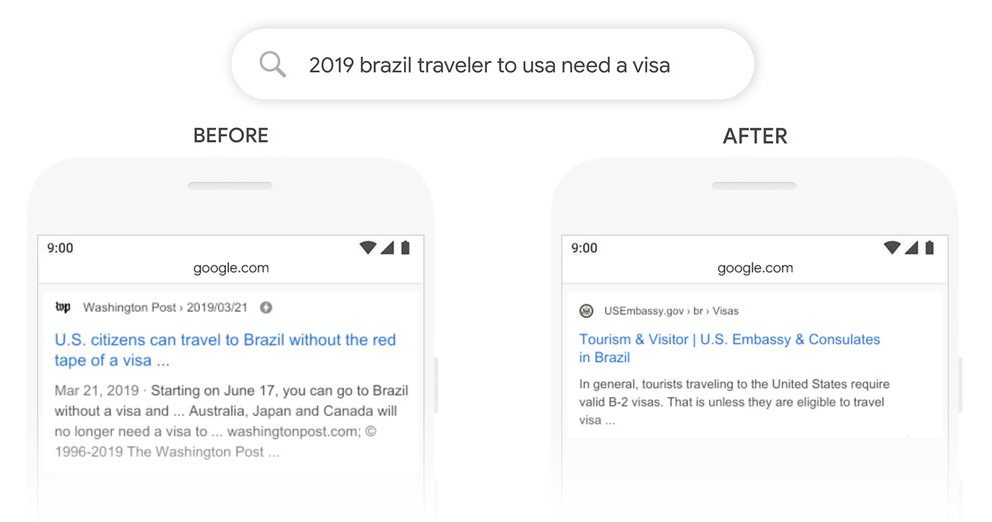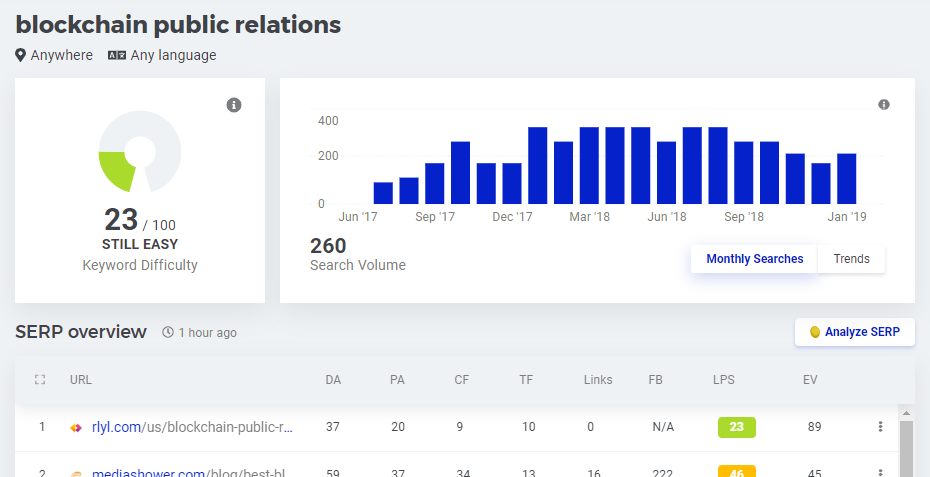Writing SEO content is never easy and a lot of the time tips and tricks are geared towards b2c industries, rather than b2b. SEO is a specialist field and if you’re at one of the many companies out there that don’t have a dedicated SEO team, then the chances are your articles aren’t ranking, or gaining the traffic levels you want. Google processes billions of search queries each day and 15% of them are brand new searches, meaning there’s a huge amount of competition.
So, how can you write b2b content which is SEO friendly? In this guide, we will provide multiple insights into how to grow traffic to your content, increase your search engine ranking and drive conversions on your site.
1. Write for people, not Google
Google’s changed a lot in the last 20 years. Gone are the days of Word Art logos and dial-up internet – we’re now in the leagues of RankBrain and competitive SEO, with Google’s natural language processing with its BERT algorithm recently changing the game once again. Powered by machine learning, Google is now able to understand conversational language instead of just keyword strings. But how does this reflect on b2b SEO, I hear you ask?
How people are searching and how Google processes search queries have both become much more focused on quality, rather than quantity. That being said, the two often go hand in hand. According to SEM Rush, content with over 3000 words gets 3x as much traffic as articles between 900-1200 words.
When writing a new piece of content, it’s important to think about how it will benefit your reader. A lot of the time when people search for things on Google, they’re looking for one of three things: information, solutions or perspectives. Often, the main content which gets produced by b2b brands is company news. Though this has its place and can often help at the decision-making stage of a buyer’s journey, most of the time readers aren’t too interested. By writing content that provides information on different topics, offers solutions to problems your target audience may be facing or simply gives a different perspective on a hot or niche topic, you can build brand recognition and start to become a recognized thought leader. This can help to drive traffic to your site and help with that all important b2b SEO.

2. Do your research
If you want your b2b content at the top of the search engine results page (SERP), then you’re going to have to put in the work. There’s a reason you always see the same companies getting top rankings across different keywords and search queries. Their content is always well researched, long-form and arguably most importantly, written around a keyword. Yes, the BERT algorithm is smarter so it can tell you mean ‘cyber security’ when you in ‘cybersecurity’ or ‘hacking’ but it needs cues and related keywords to work off.
When I talk about writing around keywords, I often discover people have a mental barrier. So, to avoid making everyone else’s eyes glaze over, I’ll try and break it down simply:
- Use a keyword research tool – discover how hard it is to rank for keywords and see how many searches they get and how competitive they are.
- Don’t go broad – this is one of the most common errors. People usually look for answers to specific problems on Google, rather than researching vague topics. You’ll have a higher chance of ranking if you write within a niche. Try thinking like the star trek computer, tools like Answer The Public can be helpful in finding questions that people use around b2b topics
- Include the keyword in your headlines and copy – now that you know what keywords you want to use, keep your main keyword in the front of your mind and make sure to include it throughout your content including the title.

Doing your research is all about providing value to your reader. By building personas, you can isolate problems your target audience may be facing, what they may be looking for from a product or service and what may already be working for them. When putting these together, as a b2b brand it makes sense to think about not only the companies you want to target, but also the decision-makers too. Who are these people, what are their job titles or seniorities and what will appeal to them? Ultimately, the goal is to uncover that key aspect that can make you stand out from your competitors.
Building accurate personas can be tricky, but by utilizing your current customers you can paint a clearer picture. Asking customers for feedback – not just on the positives and negatives of your products or services, but also on the content that led them to discover your company – can help you generate new content for businesses just like them. More details about how to define your personas can be found here.
3. Optimize the backend
Here comes the juicy part. Getting your article to rank in Google isn’t as easy as writing great content that hits your audience’s pain points (though that certainly helps)! There are a number of things you need to do to optimize your b2b content so that Google can understand your article a little better. Rather than focusing on the content, this part is more about the ‘context’.
To add context to your writing, Google looks for signposts that highlight what your article is about, how to display the page on the SERP and what the quality of the writing is like. Before publishing any articles on your brand’s site, make sure you complete the following:
- Keyword – this should be as specific as possible to your article. Check your chosen keyword through a research tool like SEM Rush or Kwfinder. Aim for the KD (keyword difficulty) to be below 40 and have an AMSV (average monthly search volume) as high as possible (we always aim for above 100 searches per country). Think about what someone might type into Google to find your article and try to avoid broad topics. Buyer intent (search queries that show someone is actively looking to make a purchase) is important for b2b.
Example: for our article ‘Blockchain Public Relations 101: the building blocks to success’, the keyword ‘blockchain’ had a very high search volume, but an incredibly high difficulty. Instead of picking this, we used keyword research to find the niche phrase ‘blockchain public relations’ which was still a highly searched term (though nowhere near as high as ‘blockchain’) with a much lower ranking difficulty.

- Keyword density – this refers to the number of times your keyword appears in your article in relation to the number of other words in the copy. Yoast SEO says keyword density should be between 0.5% and 2.5% of your article. But remember: don’t stuff keywords in just to fill the quota. Try to make sure they and any related b2b keywords appear as naturally as possible.
- Internal links – try and include at least 2 internal links (links that go to other pages on your website). These should be relevant to the article you’re writing, such as a related blog or a services page linked to a similar topic.
- External links – external links are those which link to other websites. Try and include at least two external links that are complementary to the topic you’re writing about.
Top Tip: don’t link to other pages that are trying to rank for the same keyword, as you’re both competing for the top spot on the SERP.
- Title – the article title is measured by space taken up rather than character limits. Tools like Yoast SEO are great for showing if your article title to too long for Google to display it all. Try and avoid having your title too long because google will cut it short on the SERP and your target audience may miss that vital point that makes it stand out to them.
Top Tip: try to have your keyword towards the beginning of your title so your audience can quickly and clearly see what it’s about.
- Length – b2b articles have a much better chance of ranking in search engines the longer they are. We always say we want an article to be at least 500 words but the shorter they are, the less likely they are to show up on rankings. Articles below 300 words very rarely rank, as Google’s algorithm struggles to work out what it’s about. As discussed earlier, quality over quantity but a detailed and well-written 3000 word articles with images and videos won’t do you any harm.
Fun fact: this article is 2982 words long.
- Meta description – this is the text below the title which appears on the SERP. Meta descriptions should be less than 156 characters, include the keyword and entice people to click. Not such a scary part of b2b SEO after all!
- Slug – this is the part of the URL after the domain, that is specific to your article. This should be a max of 3-6 words and include your keyword. Words from the title usually fit in here.
Example: this article’s slug is /uk/content-writing-b2b-seo/. As you can see, we have four words from the title, two of them being the keyword (b2b SEO).
- Alt tags – these are little bits of HTML mark-up (don’t panic, I’m not done yet!) that describe what an image is to Google. If an image doesn’t load for whatever reason, alt text is often displayed instead so people can tell what the image is supposed to be.
When it comes to b2b SEO, a lot of the time images are often abstract or maybe not directly related to what your article is about. For example, if you’re writing an article about a specific audience pain point, you might add an image of someone sitting at a computer looking stressed. Try and include your keyword in the alt text in context to the image. Instead of having an alt tag saying ‘stressed person at a computer’, try ‘stress from your keyword’.
4. Promote your content
Let’s get one thing clear: just because you’ve written a great piece of content and maybe even ticked off all the things from the SEO checklist, it doesn’t necessarily mean your article is automatically going to rank or get found by your target audience. Promoting your content is a vital next step once you’ve finished writing. After all, you don’t want all your hard work to go to waste do you!
There are many different ways you can promote your content but here are our top four:
- Newsletter – although GDPR, EU, and USA data restrictions have come into play in recent years, newsletters aren’t dead! Tools like Mailchimp make it easy to send newsletters to your existing client database so you can regularly promote your content to people who have shown genuine interest in you.
FYI: you can sign up to our newsletter here for similar content each month!
- Social media – certainly in the US and most of Europe, b2b social media has been dominated by LinkedIn for years and since it has now become a more content focussed platform. It’s easier than ever to promote your work. Using LinkedIn’s publishing tool, you can take advantage of its algorithm, which favors this type of content. We suggest publishing the first few paragraphs of your article and including a ‘read more’ link back to the full piece on your site.
- Link building – though this isn’t really a ‘promotion’ strategy, link building can help with b2b SEO dramatically, as well as drive traffic to your content from other sites. Setting up an outreach program and asking other relevant content creators to link back to your work will make you more reputable and you can even share some of their traffic. If your content is high quality and relevant, other content creators will be more likely to link back to you because you will be strengthening their content too.
- PPC and social advertising – Though pay-per-click and social advertising may not directly improve your search engine ranking, you can still drive traffic to your site which helps gain visibility, build brand awareness and improve your chances of gaining backlinks, which does affect b2b SEO. Google Search and Display ads, Twitter ads and LinkedIn ads all have their own benefits in b2b industries, but LinkedIn ads in particular are highly targeted as you can filter by company, seniority, location and more.
Additional reading: click here to learn about LinkedIn’s Objective-Based Advertising.

Suggested Post
Talking TechComms: b2b social media marketing
In 2020, social media and digital marketing professionals are competing in a more saturated space than...
Read More5. Keep your content up to date
So you’ve written the best piece of content in the world, you’ve done a great job on your b2b SEO and you’ve got your article to rank high up on Google. Well done, but the work’s not over yet!
Over time, other people are inevitably going to write new, fresh content around the same keyword as you. It’s easy to sit idly by at the number one spot feeling good about yourself, but sooner than you think, someone will take your position. It’s up to you to keep your article up to date. By doing the following things, you can make it look like your article was written today:
- Adding additional content – by continually developing your blog and adding further insight, Google and people alike will recognize the value of your writing and you’ll be rewarded with that long-term top tier prowess.
- Updating stats and images – updating stats are a great way of keeping your content up to date for your reader. Ask yourself this: are you going to trust an article based on 2016 stats or 2020 stats? Google will pick up on the dates within the article (as well as in the heading/sub-headings) and will recognize its relevance (or lack thereof). The same goes for images – changing them up shows that your blog is being continuously updated.
Remember: don’t forget to update the image alt tags.
- Checking for broken links – you’ve heard of link building from the previous section, but what about checking for broken links? Hyperlinks in your blog (and throughout your site) which go to 404 pages and non-existent pages in general, can negatively impact your SEO. Using tools like Broken Link Check can show you which links on your site need fixing and which pages they’re on. Once these have been found, you can remove them or replace them with a similar relevant page.
- Optimizing the user experience (UX) – when adding additional content to blog posts or when creating a pillar page, things can quickly get saturated and disorganized. Optimizing your UX can help by making your page easier to navigate and in turn, keeping people on your page longer. Including things like additional subheadings, dividers and an index can help make your content easier on the eyes and help readers discover exactly what they’re looking for.

6. Consider how people search through voice
Though voice search has taken off in recent years with the likes of Google Home and Amazon Alexa creeping into homes and being owned by 26.2% of adults in the USA, b2b adoption has so far been a slow process. But just because it hasn’t skyrocketed in the same way as b2c, it doesn’t mean voice search should be ignored. In fact, optimizing your content for voice can help with your site’s overall SEO value. At this stage in time, b2b brands can monopolize voice search queries in their broader industry by providing answers to questions that their target audiences are likely to search for. Not only does this give brands the opportunity to provide value and do some self-promotion, Google also helps with your brand recognition by stating the source of its answer every time, i.e. your brand name!
So what can you do to increase the chance of having your content chosen for voice search?
Similarly to ranking on a SERP, first you must consider the language your audience uses to search. When searching through voice, 16% of voice queries contain one of three words: how (8.64%), what (5.01%) or best (2.63%). By including question words in your title, you will be much more likely to answer the direct question a user asks, for example “What are some b2b product launch tools”.
Although it’s designed for traditional word searches, again Answer the Public can also help guide you on the type of questions worth answering around your keyword. This is useful because not only will you be able to include the keyword you want to write about, but you will also have a title in question format, which is how people tend to search with voice. One thing to remember however is that the types of questions that people are prepared to ask a public voice-enabled device in an office or in front of colleagues could be different to what they will type in on a more private device like a laptop or mobile!
When writing your content for voice optimization you want your content to be conversational and not overly technical. If you’re overly complex in your wording, Google may not understand what you’re talking about and will be unsure whether your content can answer the question. This doesn’t mean that your content has to be light or lacking in depth. You can improve your chances of having a snippet of your content read out by structuring it in a voice-friendly way. Subheadings, bullet or number points are a great way to break down components of your answer, and cover smaller topics within a larger theme.
So, there you have it! Although there’s plenty to think about when it comes to SEO, creating b2b content that will both rank highly and drive traffic to your website shouldn’t be thought of as an impossible task. Follow this guide when writing your next blog or thought leadership article and you’ll be well on your way to producing content that really hits the mark.
SEO can be a tricky area. To find out more about SEO or our digital marketing services, drop us a line at hello@rlyl.com or visit our Contact Us page.




